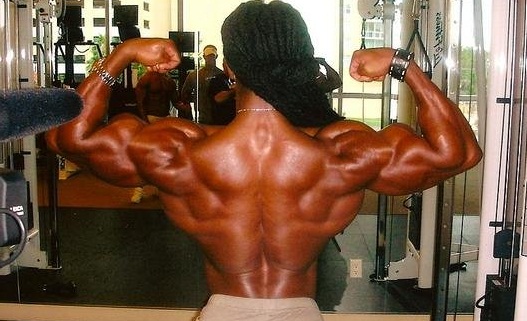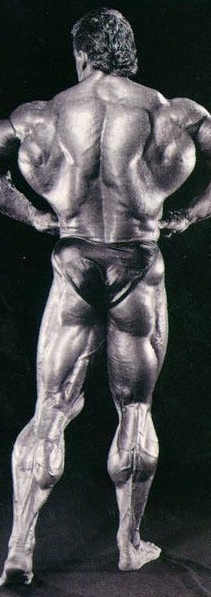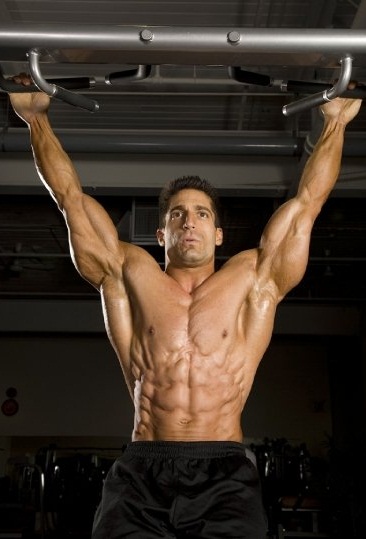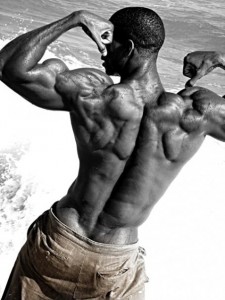It’s complicated. Combining ball-and-socket joints that allow maximum arm mobility, a ribbon of snaking bones and nerves that divide the region down the middle, and a phalanx of big and small muscles spread from your butt to your neck, your back is your most complex bodypart. So it’s little wonder that many bodybuilders earn failing grades for training it. A lot of things can go wrong, but we’ve simplified the list to a top five. In this article, we examine the most frequent back blunders and lay out easy solutions for getting your back on course.

#1 Missing the target
 Because your back is such a vast and complicated muscle group, there is much confusion about how to best train various areas. Many believe you simply need to pull your hands to the area you want to stimulate–low for lower lats, high for upper lats, etc.–but it’s not that easy to hit the target.
Because your back is such a vast and complicated muscle group, there is much confusion about how to best train various areas. Many believe you simply need to pull your hands to the area you want to stimulate–low for lower lats, high for upper lats, etc.–but it’s not that easy to hit the target.
Solutions
- For lat width, focus on chins and pulldowns with a grip wider than shoulder width.
- For lat thickness, focus on freeweight rows: barbell, T-bar and dumbbell.
- The key to lower lat activation is keeping your elbows close to your sides and pulling them as far back as possible. Two good exercises are underhand, shoulder-width pull-downs and one-arm low-cable rows, both performed with maximum ranges of motion at the contractions.
- To hit your middle, upper-back muscles–especially the rhomboids, and lower and middle trapezius–do wide-grip rows pulled to your chest. Using a Smith machine or a low cable while seated, instead of a barbell, can make balancing easier when rowing to your chest.
#2 Neglecting the lower back
One area not mentioned in our preceding rundown is spinal erectors. That’s because the most common problem here is not in missing the target, it’s in failing to even try. It is true that your lower back is stimulated during virtually any standing exercise, but to maximize the size and strength of your lower erector set, you need some isolation time, too.
Solutions
- Do deadlifts at least every other back workout. Deads work your spinal erectors in conjunction with numerous other muscles.
- Do 4-6 sets of lowerback isolation exercises at the end of each back routine.
- Back extensions, stiff-leg deadlifts (note: these are different from Romanian deadlifts, which involve less flexion and extension of the spine, and more hip flexion and extension to focus on the hams and glutes) and good mornings are excellent erector isolators. Another exercise is the back crunch, which begins like a back extension, but is a much shorter movement. Instead of bending at your waist/hips, contract your abs and curl your torso down (as if doing an ab crunch), and then rise back up by contracting your erectors.
#3 Attention to your grip
 You know the truism that a chain is only as strong as its weakest link. This applies to every bodybuilding exercise, but it’s especially true of back work, where several secondary muscles and muscle groups (hands, forearms, biceps, rear delts) work in conjunction with your lats and other posterior muscles.
You know the truism that a chain is only as strong as its weakest link. This applies to every bodybuilding exercise, but it’s especially true of back work, where several secondary muscles and muscle groups (hands, forearms, biceps, rear delts) work in conjunction with your lats and other posterior muscles.
Typically, your hands are the weak link in this chain, and if your grip gives out first, you won’t be able to maximally stimulate your back, no matter how strong all the other links are.
Solutions
- An underhand grip involves the biceps more and can place you in a stronger position, allowing you to use more weight. Incorporate both underhand and overhand grips into your back routine.
- Whether overhand or underhand, always wear training straps for any row, chin or pulldown. In research performed by the Weider Research Group, trained bodybuilders using straps during a typical back workout increased the number of reps they were able to complete by one or two on every set of every exercise compared to when they did the same back workout with bare hands.
- We recommend bodybuilders use straps during deadlifts, but if you want to increase strapless dead strength for powerlifting or other sports, alternate your grip by using what is known as a staggered grip (one hand underhand, one hand overhand) to better secure the bar in your grasp. A study presented at the 2007 Annual Meeting of the National Strength and Conditioning Association by researchers from the Weider Research Group found that trained lifters using a staggered grip significantly increased their strength on the deadlift compared to an overhand grip with both hands.
#4 Overreliance on machines
The back is complex and the elbows can travel a great multitude of paths when pulled backward, so most modern gyms offer several unique rowing machines: high rows, low rows, unilateral rows, row/pulldown combinations, etc. This has encouraged too many bodybuilders to forgo barbells, dumbbells and chinning bars on back day and instead rely primarily on levers, pulleys, cams and cables.
Machines may be more comfortable and lock you into a safe position, but a freer range of motion is generally superior for muscle stimulation.
Solutions
- As mentioned previously, do deadlifts at least every other back workout–with free weights, of course.
- Do at least one type of free-weight row–barbell, T-bar or dumbbell–in each back workout.
- In place of or in addition to pulldowns, do chins at least every other back workout. If you’re not strong enough to get 8 reps on your own, lighten your bodyweight by either having a partner slightly lift up on your feet, lightly resting your feet on a bench beneath the bar or using a chin assist machine.
#5 Overusing secondary muscles
 Bodybuilders who have trouble isolating their latissimus dorsi muscles tend to go either too heavy with sloppy form, thus overrelying on momentum and their spinal erectors, or pull too much with their biceps and/or rear delts, thus never fully stretching or contracting their lats. Because you cannot watch your back work while you are training it, it’s especially crucial to master proper form by feeling stretches and contractions during rows, pulldowns and other posterior lifts.
Bodybuilders who have trouble isolating their latissimus dorsi muscles tend to go either too heavy with sloppy form, thus overrelying on momentum and their spinal erectors, or pull too much with their biceps and/or rear delts, thus never fully stretching or contracting their lats. Because you cannot watch your back work while you are training it, it’s especially crucial to master proper form by feeling stretches and contractions during rows, pulldowns and other posterior lifts.
Solutions
- Work the weight, don’t let it work you. Use a weight you can comfortably handle with strict form for 8-12 reps.
- Pull with your elbows, bringing them back and/or down as far as possible.
- If your biceps are doing too much of the work, utilize only an overhand grip.
- Focus on the targeted area of your back. Don’t focus on the weight or the path of the movement.
- Do back isolation work, such as straight-arm pulldowns. Because rows and pulldowns/pullups involve movement at the elbows, they are multijoint exercises that use other muscle groups, such as the biceps, in addition to the back muscles. Therefore, these exercises do not isolate the lats. To isolate the lats, include one exercise that does not involve movement at the elbows, such as straight-arm pulldowns. Do these toward the end of training, after rows and pulldowns/pullups.
Lessons Learned
- Target a specific area during every back exercise.
- At the end of each back workout, do isolation work for your spinal erectors.
- Use training straps to secure your grip.
- Include free-weight and bodyweight basics in every back workout.
- Minimize momentum and feel the targeted area working throughout every rep.
- Utilize lat isolation exercises, such as straight-arm pulldowns.
Author: Greg Merritt
References:
http://www.muscleandfitness.com/
http://www.flexonline.com/
COPYRIGHT 2010 Weider Publications
COPYRIGHT 2010 Gale Group










